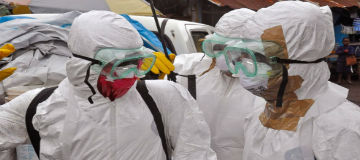Screening suspected patients for Ebola Virus Disease (EVD) in healthcare facilities
Standard Operating Procedure
Federal Ministry of Health, Nigeria
 Currently, the Ebola Virus Disease (EVD) outbreak in West Africa is predominantly in Guinea, Sierra Leone and Liberia. However, all countries are at risk, particularly those in this region.
Currently, the Ebola Virus Disease (EVD) outbreak in West Africa is predominantly in Guinea, Sierra Leone and Liberia. However, all countries are at risk, particularly those in this region.
Avoiding panic or stigma is a critical concern. The virus is transmitted through direct contact with contaminated body fluids. Usually this is in the case of very close contact, family members, health care workers delivering close direct care, some funeral ritual observances. For this reason, maintaining proper distance and hygiene is essential.
A hotline is available for questions (080.0326.6524.357)
SCREEN-ISOLATE-NOTIFY
SCREEN/triage individuals
- Conduct the interview from a respectful distance of 1-2 meters.
- No extra personal protective equipment is required when interviewing the patient if this distance is maintained. Should you wish to wear gloves, that is acceptable.
- If the patient is vomiting, bleeding, or having diarrhea at the visit, they should be moved immediately to a seperate area and PPE should be used (gown, gloves, mask, goggles or face shield, and shoe covers)
1. Interview the patient.
- Ask about these symptoms: fever, vomiting, diarrhea, bleeding (at mucous membranes or in stool), headaches, muscle aches, joint aches, weakness.
- Be mindful tha most people with fever will not have EVD, even from affected areas. When in doubt, confer with a physician on how to proceed.
- If a temperature must be taken, do so carefully with gloves and without touching the patient.
2. Ask about these exposures:
- The patient has visited an affected area within the past 3 weeks OR has had contact with an ill individual who had visited an affected area within 3 weeks of becoming ill.
- Close contact with a confirmed case of EVD.
- Close contact with a person who died, if the person who died (from a febrile illness or unexplained cause) had visited an affected area within 3 weeks of becoming ill.
- Participated in a funeral service within 3 weeks of having a fever where the funeral was held in an affected area; or
- The decedent had been in an affected within 3 weeks of becoming ill.
3. Determine if a patient has possible Ebola Virus Disease:
ANY SYMPTOMS + ANY EXPOSURE
- If the patient does not meet these criteria, but the staff remains suspicious for EVD, seek consultation with a physician. The response team is available for consultation with your medical staff.
- Perform hand hygiene immediately after seeing the patient. Clean your hands with soap and water, alcohol-based hand rub, or chlorine solution 0.05%.
ISOLATE Patients with suspected Ebola Virus Disease.
- Have the patient move immediately to an area isolated from patients and staff, such as a separate room.
- The patient should not be in contact with any persons, including clinical staff, until the ambulance team arrives.
- Should the patient be critically ill and the health care team on site must administer care and is trained, barrier PPE is essential.
- Gown, gloves, mask and eye coverings are essential.
- Shoe or boot covers and head cover is optional.
- If these items are not available, try using plastic bags and tape as a barrier.
- If the patient had active vomiting, diarrhea or bleeding, secure the soiled area so that it is seperate from any persons. You can place a chair, tape, or other object to block access to the soiled area.
NOTIFY the health authorities immediately in order for patient collection to be arranged (080.0326.6524.357)